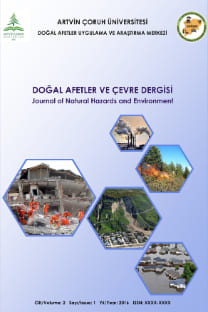MPS ve FEM Tabanlı Akışkan-Yapı Etkileşimi Modelinin Çoruh Nehri Üzerindeki Ardıl Baraj-Yıkılma Problemine Uygulanması
Application of MPS and FEM based Fluid-Structure Interaction Model to a Sequential Dam-Break Problem on Çoruh River
___
- Bathe K.J., (1982), Finite element procedures in engineering analysis, Prentice-Hall, Englewood Cliffs, New Jersey, USA, 735ss.
- Bathe K.J., Chaudhary A., (1985), A solution method for planar and axisymmetric contact problems, International Journal for Numerical Methods in Engineering, 21, 65-88.
- Bathe K.J., Zhang H., Ji S., (1999), Finite element analysis of fluid flows fully coupled with structural interactions, Computers & Structures, 72(1-3), 1-16.
- Dowell E.H., Hall K.C., (2001), Modeling of fluid–structure interaction, Annu. Rev. Fluid Mech., 33(1), 445–490.
- Hwang S., Khayyer A., Gotoh H., Park J., (2014), Development of a fully lagrangian MPS-base coupled method for simulation of fluid– structure interaction problems, J. Fluids Struct., 50, 497–511.
- Khayyer A., Gotoh H., (2008), Development of CMPS method for accurate water-surface tracking in breaking waves, Coast. Eng. J., 50(2), 179–207.
- Khayyer A., Gotoh H., (2009), Modified moving particle semi-implicit methods for the prediction of 2d wave impact pressure, Coast. Eng., 56(4), 419–440.
- Khayyer A., Gotoh H., (2011), Enhancement of stability and accuracy of the moving particle semi-implicit method, J. Comput. Phys., 230(8), 3093–3118.
- Khayyer A., Gotoh H., (2013), Enhancement of performance and stability of MPS mesh-free particle method for multiphase flows characterized by high density ratios, J. Comput. Phys., 242, 211–233.
- Koshizuka S., Oka Y., (1996), Moving particle semi-implicit method or fragmentation of incompressible fluid, Nucl. Sci. Eng., 123, 421–434.
- Ohayon R., Felippa C.E., (2001), Advances in computational methods for fluid–structure interaction and coupled problems, Comput. Methods Appl. Mech. Eng., 190, 2977–3292.
- Tanaka M., Masunaga T., (2010), Stabilization and smoothing pressure in MPS method by quasi-compressibility, J. Comput. Phys., 229(11), 4279–4290.
- Tezduyar T., Bazilevs Y., (2008), Fluid–structure interaction, Comput. Mech., 43, 1–189.
- ISSN: 2528-9640
- Yayın Aralığı: 2
- Başlangıç: 2015
- Yayıncı: Artvin Çoruh Üniversitesi Doğal Afetler Uygulama ve Araştırma Merkezi
ALİ ERSİN DİNÇER, ABDULLAH DEMİR
KAZIM ONUR DEMİRARSLAN, DENİZ DEMİRARSLAN
Artvin Çoruh Üniversitesi Seyitler Yerleşkesinin Güz Dönemi Katı Atık Karakterizasyonu
Mehmet Ali AYDIN, EMRE AYDIN, KAZIM ONUR DEMİRARSLAN
Çimento Fabrikalarında Alternatif Hammadde ve Yakıt Kullanımı: Örnek Çalışma
